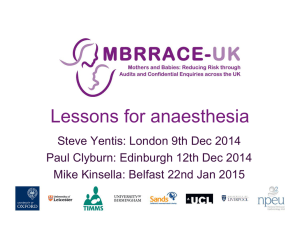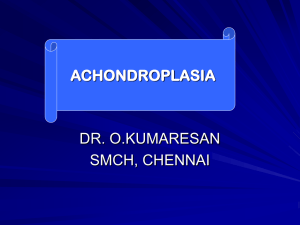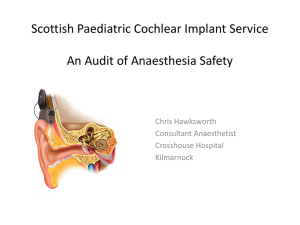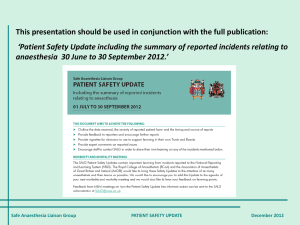Ophthalmic regional anaesthesia COA
advertisement
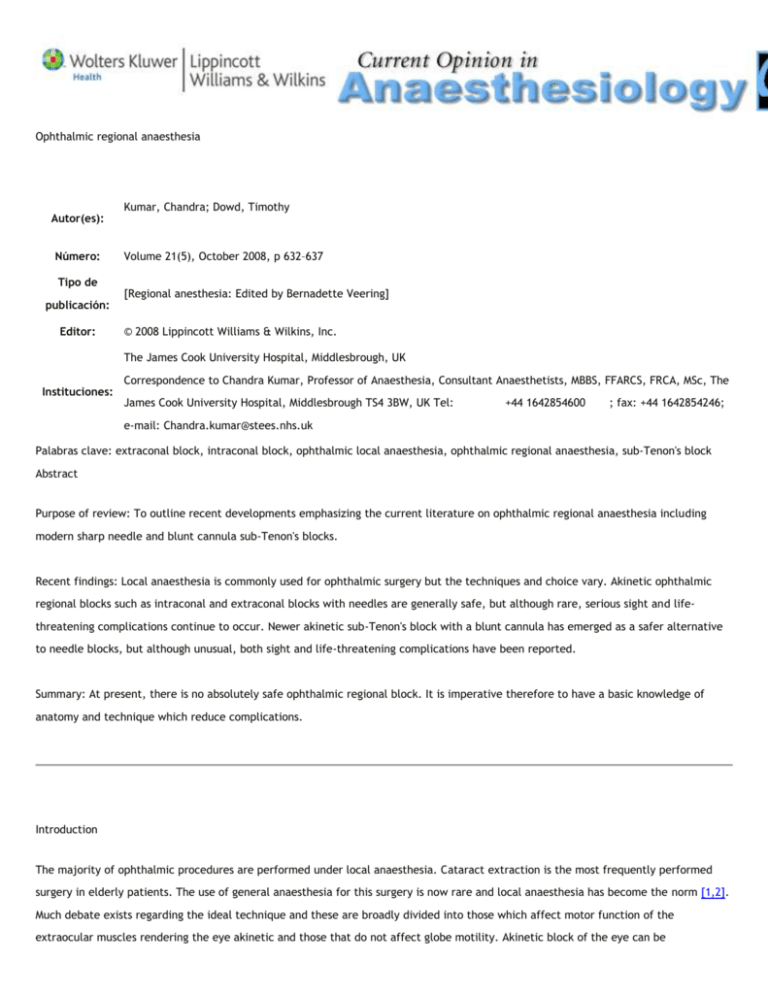
Ophthalmic regional anaesthesia Autor(es): Número: Tipo de publicación: Editor: Kumar, Chandra; Dowd, Timothy Volume 21(5), October 2008, p 632–637 [Regional anesthesia: Edited by Bernadette Veering] © 2008 Lippincott Williams & Wilkins, Inc. The James Cook University Hospital, Middlesbrough, UK Instituciones: Correspondence to Chandra Kumar, Professor of Anaesthesia, Consultant Anaesthetists, MBBS, FFARCS, FRCA, MSc, The James Cook University Hospital, Middlesbrough TS4 3BW, UK Tel: +44 1642854600 ; fax: +44 1642854246; e-mail: Chandra.kumar@stees.nhs.uk Palabras clave: extraconal block, intraconal block, ophthalmic local anaesthesia, ophthalmic regional anaesthesia, sub-Tenon's block Abstract Purpose of review: To outline recent developments emphasizing the current literature on ophthalmic regional anaesthesia including modern sharp needle and blunt cannula sub-Tenon's blocks. Recent findings: Local anaesthesia is commonly used for ophthalmic surgery but the techniques and choice vary. Akinetic ophthalmic regional blocks such as intraconal and extraconal blocks with needles are generally safe, but although rare, serious sight and lifethreatening complications continue to occur. Newer akinetic sub-Tenon's block with a blunt cannula has emerged as a safer alternative to needle blocks, but although unusual, both sight and life-threatening complications have been reported. Summary: At present, there is no absolutely safe ophthalmic regional block. It is imperative therefore to have a basic knowledge of anatomy and technique which reduce complications. Introduction The majority of ophthalmic procedures are performed under local anaesthesia. Cataract extraction is the most frequently performed surgery in elderly patients. The use of general anaesthesia for this surgery is now rare and local anaesthesia has become the norm [1,2]. Much debate exists regarding the ideal technique and these are broadly divided into those which affect motor function of the extraocular muscles rendering the eye akinetic and those that do not affect globe motility. Akinetic block of the eye can be accomplished by injection of local anaesthetic in or around the muscle cone through a needle or by instilling local anaesthetic under the Tenon's capsule using a blunt cannula. Anaesthesia without motor blockade is accomplished with topical application of local anaesthetic drops or gel and by intracameral injection of preservative-free local anaesthetics. The contents of this review article are relevant to akinetic blocks. Nomenclature of ophthalmic regional anaesthesia The terminology used for regional ophthalmic block is controversial. A name based on the likely anatomical placement of the needle is accepted widely [3]. An intraconal (retrobulbar) block involves the injection of a local anaesthetic agent into the orbital cavity (muscle cone), behind the globe formed by four recti muscles and the superior and inferior oblique muscles (Fig. 1). In the extraconal (peribulbar) block introduced in 1986 as a safer alternative to retrobulbar block, the needle tip remains outside (Fig. 2) the muscle cone [4]. Descriptions of both retrobulbar and peribulbar blocks vary but nevertheless are commonly used in the published literature [2]. Indeed, Thind and Rubin [5] have highlighted in an editorial that a wide range of local anaesthetic injection techniques are in use, some of which may be described as retrobulbar by one clinician and peribulbar by another. Multiple communications exist between the two compartments and it is difficult to differentiate whether the needle is intraconal or extraconal after placement. Computerized tomography (CT) studies after intraconal and extraconal injections of radio-contrast material have demonstrated the existence of multiple communications between these two compartments, the injected material diffusing between the compartments [6]. Injected local anaesthetic agent diffuses and depending on its spread, anaesthesia and akinesia may occur. It is appropriate to assume in clinical settings that if there is a rapid onset of akinesia, the needle tip or injected local anaesthetic agent has entered the intraconal area. If akinesia however is slow in onset and not complete, then the needle or local anaesthetic agent has not reached the intraconal area in a sufficient amount and the block is extraconal [7]. A combination of intraconal and extraconal block is described as the combined retroperibulbar block. In sub-Tenon's block, local anaesthetic agent is injected under the Tenon's capsule [8]. This block is also known as parabulbar block [9], pinpoint anaesthesia [10] or medial episcleral block [11]. Figure 1 Intraconal block Figure 2 Extraconal block Practice of ophthalmic regional anaesthesia Provision of ophthalmic local anaesthesia varies and there is no recent published literature, which indicates the exact use of a particular technique worldwide. According to a survey [12], local anaesthesia was used commonly in patients undergoing cataract surgery with topical anaesthesia with or without sedation and intracameral (56%), peribulbar (19%), retrobulbar with or without facial nerve block (23%) and others 2%. Phacoemulsification of cataract and lens implant may be performed under topical anaesthesia with or without sedation in selected patients [2] but other intraocular procedures (extracapsular cataract extraction, trabeculectomy, vitreoretinal surgery, etc.) and extraocular procedures (strabismus surgery, retinal detachment, etc.) require complete anaesthesia and akinesia. According to a recent report ‘Cataract National Dataset Electronic Multicentre Audit of 55 567 operations: anaesthetic techniques’ [13••], local anaesthesia was used in 95.5%, with topical anaesthesia alone (22.3%), topical and intracameral (4.7%), sub-Tenon (46.9%), peribulbar (19.5%) and retrobulbar in 0.5%. Although there is a lack of published data worldwide on the use of local anaesthetic technique, it appears that needle block remains a common technique in many countries [14•], whereas sub-Tenon's block is established in only a few [15••]. Choice and preference of ophthalmic regional anaesthesia There are numerous studies illustrating the diversity of preference for anaesthetic technique. Similar diversity occurs in reports of patient preference. Friedman et al. [16] reported that 72% of patients preferred an anaesthetic block to topical anaesthesia. Ruschen et al. [17] also supported this view with patients reporting higher satisfaction scores with sub-Tenon's block over topical anaesthesia alone. According to an evidence report [18], there are conflicting reports on the relative effectiveness of akinetic blocks suggesting peribulbar and retrobulbar anaesthesia produce equally good akinesia and equivalent pain control. There is insufficient evidence in the literature however to make a definitive statement concerning the relative effectiveness of sub-Tenon's block in producing akinesia when compared with peribulbar or retrobulbar block. However, individual studies [19••] reveal different and sometimes contradictory conclusions. The choice of which technique to use will always depend on a balance between the patient's wishes, the operative needs of the surgeon, the skills of the anaesthetist and the type of surgery. Assessment and preparation of patients before ophthalmic regional anaesthesia Preoperative assessment is usually limited to medical history, drug history and physical examination. The UK Joint Colleges Working Party Report [20] recommended that routine investigations are unnecessary. Tests are only performed to improve the general health of the patient if required [18]. Patients are not starved unless sedation is used. Diabetic patients should receive their normal medications with food to avoid infusion of insulin [20]. However, the blood sugar level must be checked and should be within the normal range. Patients receiving anticoagulants are screened for clotting results and are advised to continue their medications unless told otherwise [21,22]. Needle blocks are generally avoided in patients receiving anticoagulants and antiplatelet agents, sub-Tenon's block or topical anaesthesia being preferred [21]. Antibiotics are not necessary in patients with valvular heart disease. Knowledge of the axial length of the eye before needle block is essential and is usually available in patients undergoing cataract surgery because eyes with an axial length more than 26 mm are more prone to globe damage [23•]. Needle blocks In 1934, Atkinson [24] described the classical retrobulbar block in which patients looked upward and inward and a 38-mm long needle inserted through the skin after the formation of a wheal between the medial two-third and lateral one-third of the inferior orbital margin. The needle was directed towards the apex and 2–3 ml of local anaesthetic injected very close to the optic nerve. Akinesia and analgesia resulted quickly but a facial nerve block was essential to block the orbicularis oculi muscle. Both retrobulbar and facial nerve blocks were associated with significant complications and the technique has recently evolved [7,23•]. In modern retrobulbar block, surface anaesthesia is obtained (oxybuprocaine or a similar eye drop especially for perconjunctival injection) and usually aqueous 5% povidone iodine instilled. The globe is kept in a neutral gaze position and a shorter needle less than 31 mm is inserted as far as possible in the extreme inferonasal quadrant either perconjunctivally or percutaneously [23•]. The needle is directed upwards and inwards but tangential to the globe and 4–5 ml of local anaesthetic agent injected. Two per cent of lidocaine remains the local anaesthetic agent of choice but all available local anaesthetic agent has been used. A separate facial nerve block is not normally required. In peribulbar block, surface anaesthesia is obtained as above. The globe is kept in a neutral gaze position and a shorter needle less than 31 mm is inserted as far as possible in the extreme inferonasal quadrant perconjunctivally. The technique is essentially very similar to retrobulbar block except that the needle is not directed upwards and inwards and the needle remains tangential to the globe but along the inferior orbital floor. A volume of 5–6 ml of local anaesthetic agent is injected specifically outside the muscle cone [7]. A supplementary injection is usually required either in the same quadrant or through an injection in the medial compartment called a medial peribulbar block. In this technique, the needle is inserted between the carcuncle and the medial canthus to a depth of 1–1.5 cm and 3–5 ml of local anaesthetic injected [7]. A single medial peribulbar block with 6–8 ml of local anaesthetic has been advocated if akinesia is essential in patients with myopic eyes [25]. Cannula block Surface anaesthesia is obtained with local anaesthetic drops (oxybuprocaine 0.4% or similar eye drop). The conjunctiva is cleaned with aqueous 5% povidone iodine. The lower eyelid is retracted or a speculum used. Using no touch technique, the conjunctiva and Tenon's capsule are gripped with a nontoothed forceps 5–10 mm away from the limbus usually in the inferonasal quadrant while the patient is asked to look upwards and outwards. A small incision is made through these layers with Westcott scissors to expose the white sclera. A sub-Tenon's cannula (2.54 cm blunt metal cannula or similar) is gently inserted along the curvature of the globe but excessive force is never applied. The injected local anaesthetic agent (4–5 ml) diffuses around and into the intraconal space resulting in anaesthesia and akinesia [8,26]. Other quadrants may also be used for sub-Tenon's block [26]. Discomfort and fear during ophthalmic regional anaesthesia Many patients are anxious prior to and during ophthalmic surgery. This can be due to anticipated pain, discomfort or fear of seeing during surgery. Fung et al. [27] measured patient satisfaction using the ‘Iowa Satisfaction with Anaesthesia Scale’ (ISAS) in patients undergoing cataract surgery. All patients received topical local anaesthesia and intravenous sedation was administered by an anaesthetist. Although patient satisfaction was high, the incidence of intraoperative and postoperative pain was 13 and 37%. They concluded that pain during and after cataract surgery is common and is a major reason for lower patient satisfaction with their treatment. With regard to pain control, there are disagreements about the superiority of an individual technique. Overall there is moderate evidence [18] that sub-Tenon's block produces better pain control than retrobulbar and peribulbar block. There is weak evidence that sub-Tenon's block produces better pain control than topical anaesthesia. A recent study [28,29••] suggests that up to 43% of patients undergoing sub-Tenon's block suffer varying degrees of pain during administration. All topical local anaesthetic drops sting on application. Proxymetacaine 0.5% and oxybuprocaine 0.4% eye drops sting least on application but do not provide adequate surface anaesthesia. Tetraciane 1% eye drops sting most but produce good surface anaesthesia. Many clinicians instil proxymetacaine or oxybuprocaine first, followed by tetracaine and this sequence seems to reduce the discomfort. Injection of any local anaesthetic agent irrespective of the type of the block is painful and associated with burning sensations around the globe giving an unpleasant experience. Local anaesthetic agents which are stored in the fridge are believed to produce more pain during injection but this has been recently discounted and it remains controversial whether warming local anaesthetic helps [29••]. Injection of diluted local anaesthetic agents before the main concentrated injection is also believed to reduce discomfort [7]. Many patients have retained visual sensation under all types of ophthalmic local anaesthesia and different types of surgery [30–32]. In one survey [33], 16% found this distressing. Anxiety results in catecholamine release. The majority of cataract patients are elderly and have comorbidities such as diabetes and cardiovascular disease. Preoperative counselling and sedation can be used to control catecholamine secretion minimizing tachycardia and hypertension. Several studies [30] have shown that an explanation of the procedure itself and counselling as to what may be expected reduces anxiety. Sedation during ophthalmic regional anaesthesia Many clinicians prefer to use sedation to reduce anxiety, discomfort and fear during ophthalmic regional anaesthesia. However, ophthalmic surgical techniques have changed over the years and hence modified the need for sedation and analgesia. The type of block used for ophthalmic surgery also alters the requirement for sedation and analgesia. Selected patients, in whom explanation and reassurance have proved inadequate, may benefit from sedation [20]. Ideally the patient should be awake and cooperative during surgery, with no residual sedation or prolonged somnolence. If sedation is used for the block, an agent with fast onset is required ensuring that the patient is amnesic but does not move during the injection. There should not be any haemodynamic or respiratory depression and no after effects so that the patient is ready for discharge soon after surgery. The routine use of sedation is discouraged because of an increased incidence of adverse intraoperative events [34]. At present, there is no consensus about what is the ideal sedative/analgesic regimen. It is essential that when sedation is administered, a means of providing supplementary oxygen is available. Equipment and skills to manage any life-threatening events must be immediately available [20]. Complications of ophthalmic regional anaesthesia Complications of needle blocks range from mild to serious and have been reported and published in many reviews [35–37]. The complications may be limited to the orbit or may be systemic. Orbital complications include failure of the block, corneal abrasion, chemosis, conjunctival haemorrhage, vessel damage leading to retrobulbar haemorrhage, globe perforation, globe penetration, optic nerve damage and extraocular muscle damage. Systemic complications, such as local anaesthetic agent toxicity, brainstem anaesthesia and cardio-respiratory arrest may be due to intravenous or intrathecal injection, spread or misplacement of drug in the orbit during or immediately after injection. Risk factors that enhance potential for accidental needle penetration of the globe include increased optical axial length, recession of the eye and limited operator experience. Intraconal injection requires placement of an acutely angled needle deep within the orbit. If the antero-posterior distance of the eye is significantly longer than average, there is a greater risk of accidental injection into the posterior part of the globe by steep angulation of the needle. Antero-posterior length is increased with myopia, staphyloma, and prior scleral buckle surgery. An in-situ scleral buckle deforms the globe, enlarging the axial length. A staphyloma is an aberrant outpouched section of globe, typically located posteriorly at the nexus of eye wall and optic nerve. Ideally, confirmation of globe length (<26 mm) and shape (no staphyloma) can be accomplished if a preoperative ultrasound has been performed. Additionally, the surface anatomy should be assessed to determine the globe–orbit relationship as the presence of marked globe recession in the orbit may enhance the risk of posterior pole puncture. The ultimate location of the tip of an intraconal block needle is typically more proximate to the posterior pole of the globe than anticipated. The extraconal approach of shallower needle placement with minimal angulation may diminish the likelihood of encountering the globe's hind surface; however, inadvertent needle penetration can nonetheless occur at the globe's periphery. This risk is particularly enhanced if the eye is myopic, as globe dimensions increase in all axes with near-sightedness. Sub-Tenon's block is considered a safe alternative to needle block; however, a number of complications both minor and major have been reported [8,26]. Commonly encountered complications of sub-Tenon's block are mostly minor. These include pain upon injection, reflux of local anaesthetic, chemosis and conjunctival haemorrhage with varying incidence. Visual analogue pain scores are typically low but outliers have been reported. Smaller cannulae may afford a marginal benefit [38]. Anterograde reflux and loss of local anaesthetic upon injection occur if the dissection is oversized relative to the gauge of the cannula. Inadequate access into the sub-Tenon's space can also promote overspill and chemosis. The incidence of chemosis varies with the volume of local anaesthetic, dissection technique and choice of cannula [19••,39]. Shorter cannulae are associated with increased likelihood of conjunctival chemosis being up to 100% in some studies [39]. Conjunctival haemorrhage is common [19••] with some studies reporting up to 100% incidence [39]. According to a recent study [40], conjunctival haemorrhage occurred in 19% in the control group, 40% in the clopidogrel group, 35% in the warfarin group and 21% in aspirin group. Occurrence can be reduced with careful dissection, application of topical epinephrine or controversially the use of handheld cautery [41,42•]. A number of major complications from sub-Tenon's blocks have been reported [8,26]. These include significant orbital haemorrhage, globe perforation, orbital cellulitis, postoperative diplopia, optic neuropathy, pupillary/accommodation defects, retinovascular and choroidovascular occlusion and central spread of local anaesthetic with cardiopulmomary sequelae including death [43••]. These complications tend to be associated with the use of longer more rigid cannulae and higher volume of local anaesthetic [8,26]. The likelihood of encountering these rare outcomes may be diminished with use of shorter flexible cannulae and low volume [44•]; however, the incidence of common minor complications rises as length and rigidity fall [45]. Conclusion Ophthalmic regional anaesthesia provides excellent anaesthesia for ophthalmic surgery with a high success rate. Satisfactory anaesthesia and akinesia can be obtained with both needle and cannula techniques. Retrobulbar, peribulbar and sub-Tenon's blocks are invasive techniques. All injection techniques are associated with pain, sight and life-threatening complications albeit rare and at present there is no absolutely safe technique. References and recommended reading Papers of particular interest, published within the annual period of review, have been highlighted as: • of special interest •• of outstanding interest Additional references related to this topic can also be found in the Current World Literature section in this issue (p. 690). 1 Kumar CM, Fanning GL. Orbital regional anesthesia. In: Kumar CM, Dodds C, Fanning GL, editors. Ophthalmic anaesthesia. Netherlands: Swets and Zeitlinger; 2002. pp. 61–88. [Context Link] 2 Venkatesan VG, Smith A. What's new in ophthalmic anaesthesia? Curr Opin Anaesthesiol 2002; 15:615–620. Ovid Full Text Bibliographic Links [Context Link] 3 Fanning GL. Orbital regional anesthesia: let's be precise. J Cataract Refract Surg 2003; 29:1846–1847. Bibliographic Links [Context Link] 4 Davis DB, Mandel MR. Posterior peribulbar anesthesia: an alternative to retrobulbar anesthesia. J Cataract Refract Surg 1986; 12:182– 184. Bibliographic Links [Context Link] 5 Thind GS, Rubin AP. Local anaesthesia for eye surgery-no room for complacency. Br J Anaesth 2001; 86:473–476. Ovid Full Text Bibliographic Links [Context Link] 6 Ripart J, Lefrant JY, de La Coussaye JE, et al. Peribulbar versus retrobulbar anesthesia for ophthalmic surgery: an anatomical comparison of extraconal and intraconal injections. Anesthesiology 2001; 94:56–62. Ovid Full Text Bibliographic Links [Context Link] 7 Kumar CM, Dodds C. Ophthalmic regional block. Ann Acad Med Singapore 2006; 35:158–167. Bibliographic Links [Context Link] 8 Kumar CM, Williamson S, Manickam B. A review of sub-Tenon's block: current practice and recent development. Eur J Anaesth 2005; 22:567–577. Bibliographic Links [Context Link] 9 Greenbaum S. Parabulbar anesthesia. Am J Ophthalmol 1992; 114:776. Bibliographic Links [Context Link] 10 Fukasaku H, Marron JA. Sub-Tenon's pinpoint anesthesia. J Cataract Refract Surg 1994; 20:468–471. [Context Link] 11 Ripart J, Prat-Pradal D, Charavel P, Eledjam JJ. Medial canthus single injection episcleral (sub-Tenon) anesthesia anatomic imaging. Clin Anat 1998; 11:390–395. Bibliographic Links [Context Link] 12 Leaming DV. Practice styles and preferences of ASCRS members: 2003 survey. J Cataract Refract Surg 2004; 30:892–900. Bibliographic Links [Context Link] 13•• El-Hindy N, Johnston RL, Jaycock P, et al., the UK EPR user group. The Cataract National Dataset Electronic Multicentre Audit of 55 567 operations: anaesthetic techniques and complications. Eye 2008 [Epub ahead of print]. This is an excellent audit of practice of ophthalmic regional anaesthesia in the UK. [Context Link] 14• Wagle AA, Wagle AM, Bacsal K, et al. Practice preferences of ophthalmic anaesthesia for cataract surgery in Singapore. Singapore Med J 2007; 48:287–290. Bibliographic Links This survey shows there is a wide variation in the practice of ophthalmic regional anaesthesia. [Context Link] 15•• Eke T, Thompson JR. Serious complications of local anaesthesia for cataract surgery: a 1 year national survey in the United Kingdom. Br J Ophthalmol 2007; 91:470–475. Buy Now Bibliographic Links This is an excellent study which looked at the practice of ophthalmic regional anaesthesia and its expected complications rate. [Context Link] 16 Friedman DS, Reeves SW, Bass EB, et al. Patient preferences for anaesthesia management during cataract surgery. Br J Ophthalmol 2004; 88:333–335. Buy Now Bibliographic Links [Context Link] 17 Ruschen H, Celaschi D, Bunce C, Carr C. Randomised controlled trial of sub-Tenon's block versus topical anaesthesia for cataract surgery: a comparison of patient satisfaction. Br J Ophthalmol 2005; 89:291–293. Buy Now Bibliographic Links [Context Link] 18 Evidence Report/Technology Assessment Number 16: anaesthesia management during cataract surgery. Rockville, Maryland, USA: Agency for Healthcare Research and Quality. Available at http://www.ahcpr.gov/clinic/epcsums/anestsum.htm . [Accessed 11 April 2008] [Context Link] 19•• Davison M, Padroni S, Bunce C, Rüschen H. Sub-Tenon's anaesthesia versus topical anaesthesia for cataract surgery. Cochrane Database Syst Rev 2007:CD006291. This is an excellent review of comparison of topical and sub-Tenon's block. [Context Link] 20 Local anaesthesia for intraocular surgery. London: The Royal College of Anaesthetists and The Royal College of Ophthalmologists; 2001. Available at http://www.rcoa.ac.uk/docs/RCARCOGuidelines.pdf . [Accessed 12 April 2008] [Context Link] 21 Koopmans SA, van Rij G. Cataract surgery and anticoagulants. Doc Ophthalmol 1996–1997; 92: 11–16. [Context Link] 22 Konstantatos A. Anticoagulation and cataract surgery: a review of the current literature. Anaesth Intensive Care 2001; 29:11–18. Bibliographic Links [Context Link] 23• Gayer S, Kumar CM. Ophthalmic regional anesthesia techniques. Minerva Anestesiol 2008; 74:23–33. Bibliographic Links A review of current ophthalmic regional anaesthesia techniques. [Context Link] 24 Atkinson WS. Retrobulbar injection of anesthetic within the muscular cone. Arch Ophthalmol 1936; 16:494–503. [Context Link] 25 Vohra SB, Good PA. Altered globe dimensions of axial myopia as risk factors for penetrating ocular injury during peribulbar anesthesia. Br J Anaesth 2000; 85:242–243. Bibliographic Links [Context Link] 26 Kumar CM, Dodds C. Sub-Tenon's anesthesia. Ophthalmol Clin North Am 2006; 19:209–219. Bibliographic Links [Context Link] 27 Fung D, Cohen MM, Stewart S, Davies A. What determines patient satisfaction with cataract care under topical local anaesthesia and monitored sedation in a community hospital setting? Anesth Anal 2005; 100:1644–1650. Ovid Full Text Bibliographic Links [Context Link] 28 Guise P. SubTenon's anesthesia: a prospective study of 6000 blocks. Anesthesiology 2003; 98:964–968. Ovid Full Text Bibliographic Links [Context Link] 29•• Allen MJ, Bunce C, Presland AH. The effect of warming local anaesthetic on the pain of injection during sub-Tenon's anaesthesia for cataract surgery. Anaesthesia 2008; 63:276–278. Ovid Full Text Bibliographic Links This is a comparative study of effects of warming local anaesthetic and conclusions suggest that warming of local anaesthetic does not help in reducing pain during sub-Tenon's block. [Context Link] 30 Tan CS, Au Eong KG, Kumar CM. Visual experiences during cataract surgery: what anaesthesia providers should know. Eur J Anesthesiol 2005; 22:413–419. [Context Link] 31 Rengaraj V, Radhakrishnan M, Au Eong KG, et al. Visual experience during phacoemulsification under topical versus retrobulbar anesthesia: results of a prospective, randomized, controlled trial. Am J Ophthalmol 2004; 138:782–787. Bibliographic Links [Context Link] 32 Riad W, Tan CS, Kumar CM, Au Eong KG. What can patients see during glaucoma filtration surgery under peribulbar anesthesia? J Glaucoma 2006; 15:462–465. Buy Now Bibliographic Links [Context Link] 33 Prasad N, Kumar CM, Patil BB, Dowd TC. Subjective visual experience during phacoemulsification cataract surgery under sub-Tenon's block. Eye 2003; 17:407–409. Bibliographic Links [Context Link] 34 Katz J, Feldman MA, Bass EB, et al. Adverse intraoperative medical events and their association with anesthesia management strategies in cataract surgery. Ophthalmology 2001; 108:1721–1726. Bibliographic Links [Context Link] 35 Rubin AP. Complications of local anaesthesia for ophthalmic surgery. Br J Anaesth 1995; 75:93–96. Bibliographic Links [Context Link] 36 Kumar CM, Dowd TC. Complications of ophthalmic regional blocks: their treatment and prevention. Ophthalmologica 2006; 220:73– 82. Bibliographic Links [Context Link] 37 Kumar CM. Orbital regional anesthesia: complications and their prevention. Indian J Ophthalmol 2006; 54:77–84. Bibliographic Links [Context Link] 38 Kumar CM, Dodds C, McLure H, Chabria R. A comparison of three sub-Tenon's cannulae. Eye 2004; 18:873–876. Bibliographic Links [Context Link] 39 Kumar CM, Dodds C. An anaesthetist evaluation of Greenbaum subTenon's block. Br J Anaesth 2001; 87:631–633. Ovid Full Text Bibliographic Links [Context Link] 40 Kumar N, Jivan S, Thomas P, McLure H. Sub-Tenon's anesthesia with aspirin, warfarin, and clopidogrel. J Cataract Refract Surg 2006; 32:1022–1025. Bibliographic Links [Context Link] 41 Kumar CM, Williamson S. Diathermy does not reduce subconjunctival haemorrhage during sub-Tenon's block. Br J Anaesth 2005; 95:562. Ovid Full Text Bibliographic Links [Context Link] 42• Gauba V, Saleh GM, Watson K, Chung A. Sub-Tenon anaesthesia: reduction in subconjunctival haemorrhage with controlled bipolar conjunctival cautery. Eye 2007; 21:1387–1390. Bibliographic Links Controlled localized bipolar conjunctival cautery before sub-Tenon's injection may significantly reduce the frequency of subconjunctival haemorrhage, especially in patients on warfarin or aspirin. [Context Link] 43•• Quantock CL, Goswami T. Death potentially secondary to sub-Tenon's block. Anaesthesia 2007; 62:175–177. Ovid Full Text Bibliographic Links This case report describes death associated with sub-Tenon's block. [Context Link] 44• Kumar CM. Low volume sub-Tenon's block. Anaesthesia 2007; 62:970–971. Ovid Full Text Bibliographic Links This article makes recommendations in the use of low volume and smaller cannulae for sub-Tenon's block towards reducing complications. [Context Link] 45 MacNeela BJ, Kumar CM. Sub-Tenon's block using ultrashort cannula. J Cataract Refract Surg 2004; 30:858–862. Bibliographic Links [Context Link] Keywords: extraconal block; intraconal block; ophthalmic local anaesthesia; ophthalmic regional anaesthesia; sub-Tenon's block



